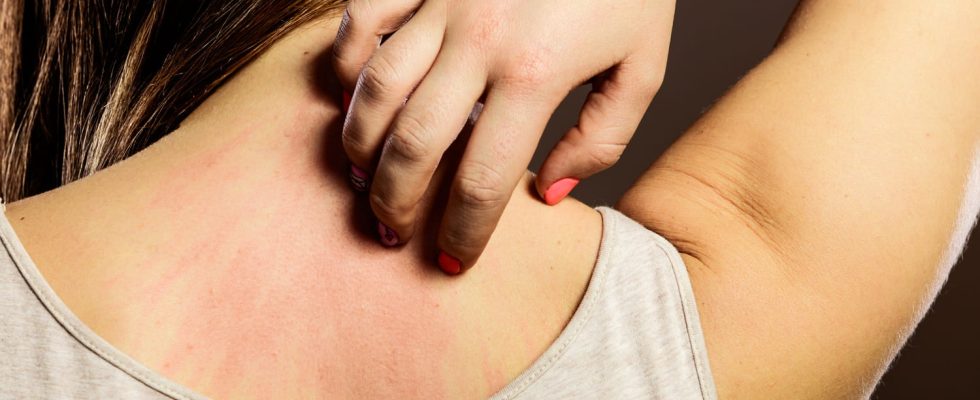Characterized by red and purple spots on the skin, purpura is a sign that can reveal different causes. Most forms of purpura are mild but some are emergency cases. What causes purpura? What are the treatments ?
Purpura is a skin pathology which manifests itself by small red or purple rashes on the skin. We distinguish the purpura fulminans, rheumatoid purpura and thrombocytopenic purpura. Purpura is secondary to inflammation of the vessel walls or a deficiency of blood platelets. It’s what purpura? What are the causes and the symptoms ? Does purpura is serious ? What are the treatments ?
Definition: what is purpura?
Purpura is a syndrome clinical. “It’s a outflow of red blood cells through small blood vessels. They spread to the surrounding tissues. explains Pr Gérard Lorette, dermatologist.
What are the different types of purpura?
► Purpura Fulminans. There are two main groups of purpura: those with a non-inflammatory cause and those with an inflammatory cause. “Even if most cases of purpura are mild in particular purpuras by capillarity, due to a fragility of the capillary vessels or significant pressure in the veins of the lower limbs – there are also more serious forms which are absolute emergencies, including purpura fulminans“ says Professor Gérard Lorette. Purpura fulminans manifests as hemorrhagic lesions on the skin that rapidly spread to develop into gangrene. It is also a disease that will affect different organs, it is caused in 80% of cases by meningococcus (bacteria responsible for meningitis). “You have to think about it when small spots appear like drops of water on cement on a stormy day” describes the dermatologist. This purpura may be accompanied by fever, headache and neck pain (meningeal signs). Purpura fulminans is a deadly disease that requires emergency treatment (by taking antibiotics).
► Rheumatoid purpura or Henoch-Schönlein disease is a form of vasculitis (inflammation of the blood vessels) which causes various symptoms, raised purpura (palpable), joint and abdominal pain, kidney damage. This disease is rather common and often mild in children. On the other hand, its consequences are greater in adulthood and its treatment slower and more difficult. Rheumatoid purpura is caused by an abnormal immune reaction.
► Thrombocytopenic purpura refers to the rash of small red spots in the skin that may appear on one or more parts of the body. It’s about a blood disease which can be idiopathic, it is relatively common in both children and adults. Thrombocytopenia may also be due to platelet production problem in the bone marrow or excessive platelet destruction. The diagnosis may in some cases require a spinal tap.
What causes purpura?
Purpura may be secondary to several mechanisms, including a inflammation of the vessel walls (vascular purpura) or a lack of blood platelets (thrombocytopenic purpura). “Purpura can be linked to a fragility of the capillary vessels. These are then no longer continents and allow red blood cells to pass” explains Professor Gérard Lorette. Among the vascular purpuras, we distinguish the inflammatory attacks called vasculitis (or vasculities) for example during an infection, a cancertaking medicationsa systemic disease such as lupus. Non-inflammatory purpuras may be related to a platelet abnormality. “Thrombocytopenic purpura is caused by a lack of blood platelets, either because a disease leads to too much platelet consumption or because there is a Myelosuppression and the body no longer produces enough“explains Pr Gérard Lorette. Thrombocytopenic purpura can have many causes, including drug causes, autoimmune diseases or leukemia.
What are the symptoms of purpura?
Purpura is manifested by the appearance of red or purple skin patches. “Depending on the type of purpura, the appearance is different” says Professor Gérard Lorette. “Petechial purpura presents as tiny red dots (or petechiae) like pinheads” he describes. This is the most classic look. “The stains can go up to bruises or appear as vibices which are linear lesions” says the dermatologist. Other manifestations are often associated with thrombocytopenic purpura such as bleedinggums in particular.
“The diagnosis is clinical“ informs Professor Gérard Lorette. Purpura is recognized by the presence of his lesions which do not disappear on vitropression, that is to say when we press on the skin. “We don’t necessarily do very complex examinations in the presence of a desk” informs Professor Gérard Lorette. A blood test, including platelet count, may be done to find the cause of purpura. If there is one thrombocytopenia, a bone marrow puncture can be performed. A biopsy can be performed when there is inflammatory involvement of the vessel wall.
Is purpura an emergency?
“When the doctor sees purpura, he first asks himself how urgent it is. There are two main emergencies: purpura fulminans, and thrombocytopenic purpura, due to a lack of platelets. When the number of platelets is less than 20,000, there is urgency because of the significant risk of bleeding. Extensive purpura is also a alarm signal in children or adolescents where he can report a invasive meningococcal diseaseextreme medical emergency.
What is the difference between purpura and erythema?
Red, purple or purple spots on the skin, do not fade on pressure (when pressed), unlike erythema. “Erythema is due to a dilation of small blood vesselsin this case pressure with the finger makes the spot disappear because the dilated vessel is crushed” specifies Professor Gérard Lorette.
What are the treatments for purpura?
The treatment obviously depends on the cause. Purpura by capillarity, the most frequent case, is often chronic and does not require treatment. When there is an inflammatory or hematological cause, specific treatments are required. In case of purpura with haemorrhagic signs, a transfusion of platelets is sometimes necessary. If it is purpura fulminans, a antibiotic therapy is started intramuscularly (cephalosporin) without waiting for the diagnosis and before the transfer to the hospital.
Thanks to Pr Gérard Lorette, dermatologist at the University Hospital of Tours and member of the French Society of Dermatology (SFD).
